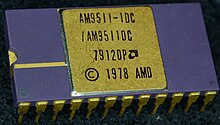Coprocessor
A coprocessor is an additional microprocessor that supports the main processor (CPU) in its work. Coprocessors can, for example , execute mathematical and floating point operations, graphics operations, signal processing, I / O processing or cryptography . These include math coprocessors, graphics processors and I / O processors. Coprocessors are supposed to relieve the main processor and reduce work by means of an architecture specially tailored to the task. You can increase the performance of the system in your area of responsibility and save electricity.
Mathematical coprocessors
A mathematical coprocessor (often also a floating point unit ) takes over the calculations of floating point numbers for the main processor. Modern processors no longer need a coprocessor for this because they have an integrated floating point unit. One of the first arithmetic co-processors was the AMD AM9511, which was addressed as a peripheral component by the microprocessor.
Well-known representatives of this genus were the mathematical floating point coprocessors Intel 8087 , Intel 80287 and Intel 80387 , since they had to be purchased as accessories in the 1980s when they came onto the market. The associated CPUs did not yet have a built-in floating point unit, so floating point calculations had to be carried out using complex software routines, which was significantly slower than floating point calculations in hardware. Many programs have therefore been developed for fixed-point arithmetic , as this can be efficiently implemented by the arithmetic-logic unit (ALU). With the i486 , x86 CPUs were equipped with a built-in floating point unit, so that the coprocessor was superfluous. In the slimmed-down low-cost version 486SX , the floating point unit was present on the die, but it was deactivated and not functional.
Motorolas 68881 or 68882 are coprocessors for other systems. Historically relevant manufacturers are also Cyrix , IIT and Weitek .
Coprocessors in I / O processing
Coprocessors are also used for I / O processing. An I / O processor ; occasionally I / O processor ( English I / O processor , IOP) is a co-processor that the central main processor supports is to process input and output operations. For this purpose, data is read from peripheral devices such as printers, scanners, monitors, mice or from storage media such as magnetic tapes, floppy disks or hard drives and written to the memory (= direct memory access (DMA)). With the help of I / O processors it is also possible to process the data that have been read out. Examples are the Intel processors Intel 8089 , IOP 341/342, MCS-48 or UPI-41 ( U niversal P eripheral I nterface) as well as the Apple M7 , which records data from motion sensors of the Apple iPhone 5s independently of a main CPU , processed and temporarily stored and thus has an energy-saving effect.
DSP
Processors for digital signal processing (DSPs) such as the Motorola 56001 or the AT&T 3210 are also considered coprocessors . More recently, Ageia's PhysX coprocessor has attracted attention for quickly computing three-dimensional physical effects.
See also
About I / O processors:
Web links
- http://coprocessor.cpu-info.com formerly Coprocessor DOT Info
Individual evidence
- ↑ Benjamin Benz: I / O processor from Intel. Reported to heise.de, October 1st, 2006.
- ↑ Anand Lal Shimpi: The iPhone 5s Review: M7 Motion Coprocessor . AnandTech. September 17, 2013. Retrieved September 18, 2013.



